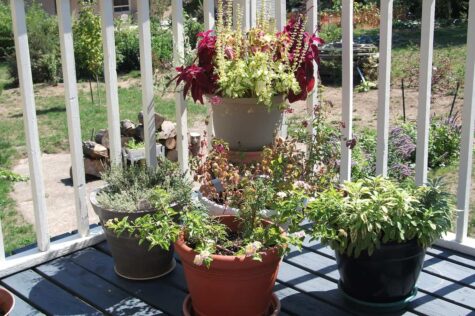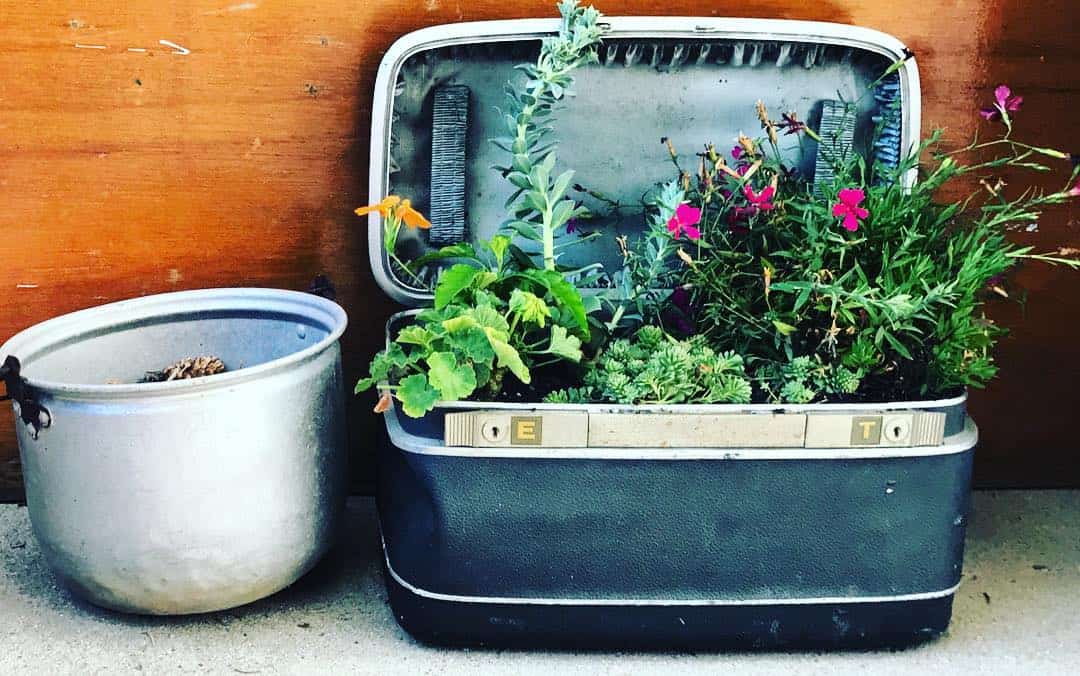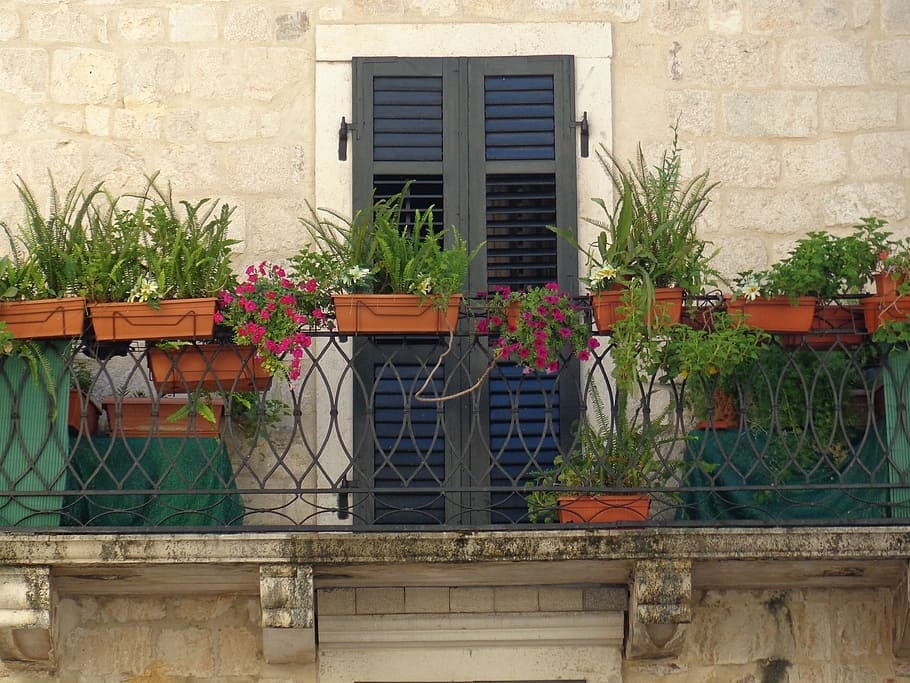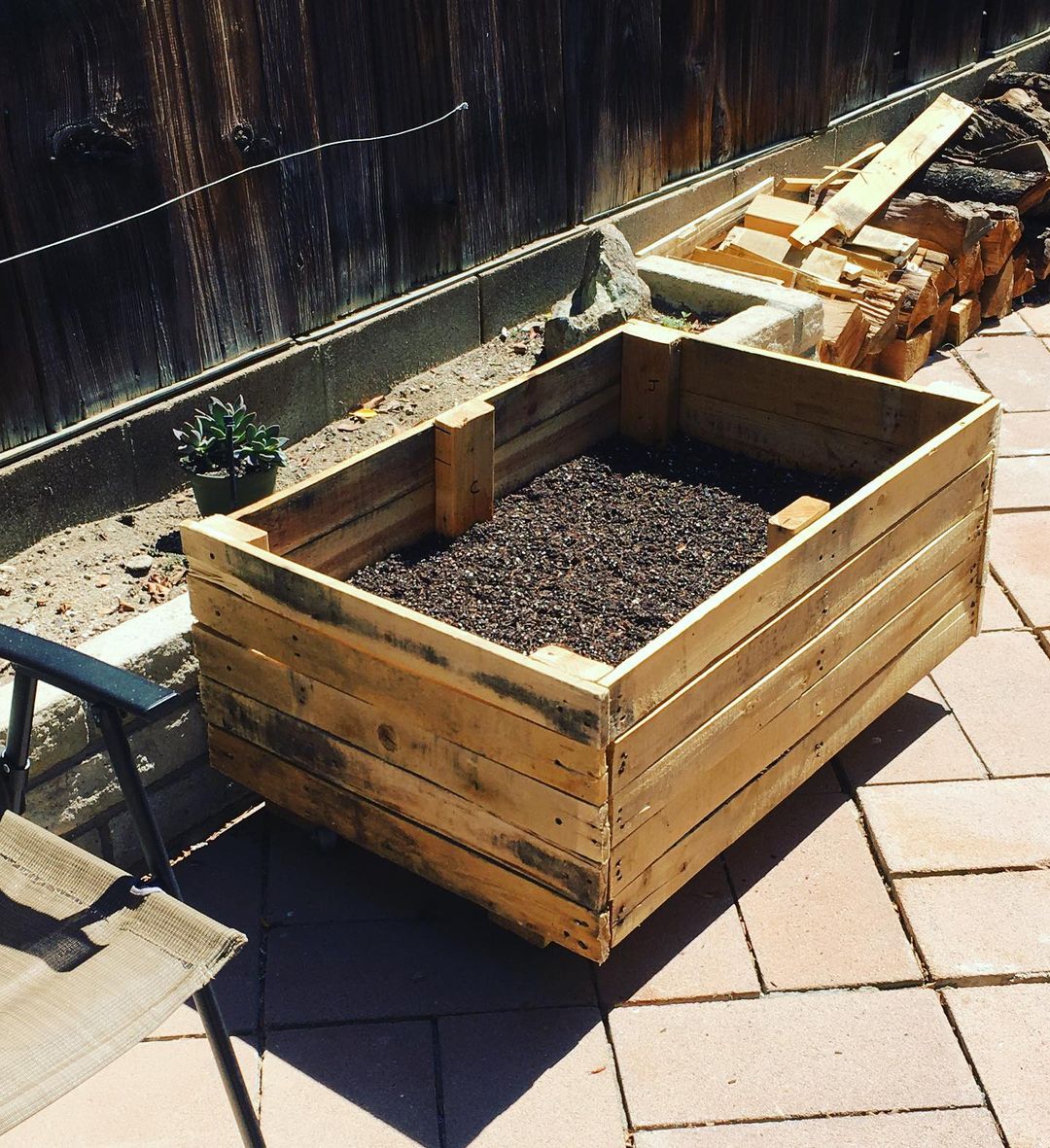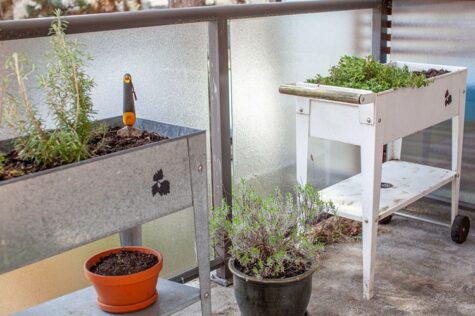Succulent plants are famous for their ability to store water in their leaves, an adaptation to growing in semi-arid or very hot conditions. Growing succulents successfully requires careful watering and a good planter box, with an excellent soil mix.
Read on to decide which planter box is best for your succulents so that you can enjoy these attractive plants for many years to come.

Create a rainbow with colourful succulents. Image credit: @kathssuccs
All planter boxes for succulents need:
Good drainage. It is important to include some sand and pebbles in the planter box. Some gardeners like to use a charcoal layer before topping up with soil or compost. Succulents are native to deserts so try to recreate similar conditions.
A tray or saucer to collect water that drains away. You’ll need to empty excess water promptly so that your succulent’s roots do not sit in moist conditions. This may cause root rot.
Natural materials such as wood and earthenware mean air can penetrate better than plastic and they also allow excess water to drain away. Succulents will grow in plastic pots but in my experience, they prefer porous material.
Room for expansion – many succulents produce suckers and smaller offshoots; some (like jade plants) become top-heavy quite quickly and may topple over, so give them plenty of room in the planter box. Think wide but not too deep in terms of the planter box size. You can also add decorative stones and rocks to stabilise them – see the landscape planter box below.
Good direct light. Succulents won’t be content in low light so ensure they’re in a sunny room for many hours of the day. That said, full sunshine is often too much for some succulents in summer so try to give some shade during the hottest part of the day. All these plants will enjoy being outdoors in summer, where they get good ventilation and lots of sunshine.
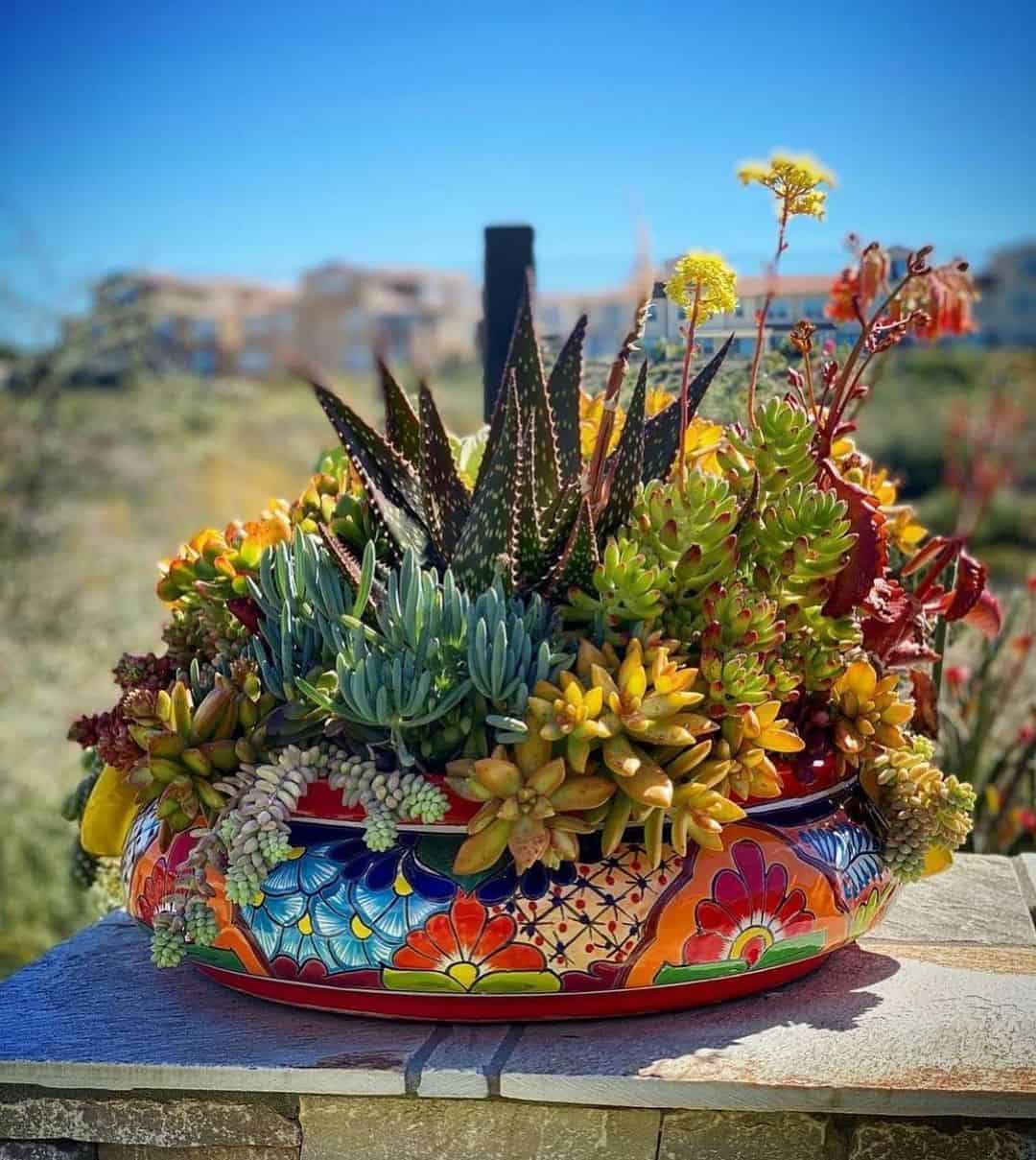
Succuluents will love basking in the hot sunshine. Image credit: @concrete_gardens
Best Planters for Succulents
So now you know what type of planters the succulents need, let’s think about incorporating them into your home or office.
1. Individual succulents
Individual succulents can be planted in earthenware pots on a south-facing sunny windowsill. Agave, aloe vera and echeveria look fabulous in single pots. Aloe vera can be used as a plant plaster too by just cutting a leaf, and using the gel on the wound. This will often stop the tears of the very young too by distraction!
Most of these plants can be propagated easily; by new offsets with roots which you can remove, or by leaf cuttings. These are great starter plants for children or inexperienced gardeners. Just discourage too much watering. Read how to water your indoor succulents properly below.

A single echeveria will brighten your home. Image credit: @bobu3744
2. Group succulents together
Group succulents like snake plants, euphoria and zebra haworthia together to improve the air quality in your home, they will cleanse the air by removing harmful toxins.
3. DIY succulent planters
DIY succulent planters can be made from most waterproof containers. Just remember that you will need to provide drainage so you may need to cut holes, add pebbles or get creative.
Some growers experiment with unusual types of planters such as wine bottles, with a cut edge and filled with soil. These green containers show off the succulent’s vibrant leaf colours really well. Make sure they’re placed away from roaming pets and curious hands.

Create unusual succulent planters from wine bottles. Image credit: @winebottlesucculents
4. Wall hanging planter boxes
Wall hanging planter boxes look fantastic with a collection of different succulent plants inside. You can mount the whole display on your wall, and place a different plant in each pot.
Painting the pots the same colour will unify the display. Hanging succulents like senecio (string of beads) will contrast really well with a sedum morganium, with its waxy, textured leaves.

The string of beads plant looks striking in wall-mounted or hanging planters. Image credit: @plantstoreireland>
5. Colourful flowering succulent plant box
Use succulents that flower at different times of the year to create a vibrant wall planter box. Try sempervivum (houseleeks), the Easter lily cactus and the prickly pear cactus for brightly coloured blooms.
You can purchase succulents that have been grafted onto cacti or bonsai and these will flower easily.
6. Landscape planter box
A landscape or rectangular planter box can be made to house several of your succulents together. You can place taller ones with a tree forming habit, like the jade plant at the back.
Echeveria succulents come in various shades; some have pink-tipped leaves and others offer fine white hairs or waxy textures. You can add a ghost plant (officially called the Graptopetalum),a native of Paraguay, which offers greenish-grey, almost white ghost-like leaves. Providing you with interest all year round, this landscape planter box will create an ever-changing picture.
If you have any large rocks, you can place these between the plants to make your box more interesting to look at. Remember that some succulents flower and if these are allowed to hang over the edge of this planter, you can have a seasonal flowering like the vivid pink Christmas cactus flower in December.

Create a living picture with colourful succulent plants. Image credit @succupots.succulents
7. Living stones planter box
A landscape planter box can be filled with the amazing lithops succulents, which resemble small, round pebbles. There are many varieties and experienced gardeners grow these in a decorative pot with stones, and then amaze their guests on the next visit when flowers appear on the “stones”.
These are really unusual and rare plants so buy one if you see one or add them to your Christmas list! This planter box doesn’t need to be very big but as they expand, you may need to re-pot them.

Wow your friends with the unusual lithops succulents. Image credit: @your_green_city
8. Layered succulent pot
A layered succulent pot will offer a vertical growing solution if space is tight. Some succulent plants will grow taller than others but you can start with a large pot and place some charcoal or sand in the base, followed by a layer of soil and plant the tallest plant centrally.
Once it is settled you can add stones to place smaller plants around it at different heights. Then you can cover the stones with topsoil or use smaller pebbles so that the drainage of the water is excellent. Lots of succulent growers use pebbles because they are an attractive way to use collected beach stones while also giving the succulents the drainage they need.

Layer succulents for visual interest. Image credit: @botanicalsmh
FAQs
How do I water my indoor succulents?
All succulents have a dormant period when they hardly need to be watered at all. This will be the plant’s own wintertime and may not occur at the same time as our winter. Check the label carefully when you buy your plants and water more when the plant is growing and less when it is dormant.
In spring and summer, feel the soil and water if it’s dry, once a week is usually enough. Before you water your succulents again test the soil by gently digging underneath and water thoroughly if dry. Drain any excess water into a saucer or tray, and empty this after approximately 30 minutes. The plant roots must never sit in wet soil for prolonged periods.
In winter, most succulents are dormant but if your house is kept very warm and centrally heated, you might find the soil is really dry. So touch the soil and check the plant. Watering once a month or so is usually enough.
Tina’s tips:
- The Christmas Cactus is the opposite of most succulents! It flowers just in time for the festive season so ensure that you water it well and fertilise it as soon as the autumn arrives. That way, the plant has all the goodness it needs to delight you in time for Christmas. Leave it drier through summer and treat that as its sleeping time.
- Ventilation. All succulents enjoy being outdoors in the fresh air, just like us humans when the sun is shining! So in a very hot summer, take your plants outdoors and if indoors, open some windows to allow the fresh air to circulate. You will be rewarded with healthy green foliage.

Enjoy festive blooms with the Christmas cactus. Image credit: @explorganics
Difference between succulents and cacti
A final word about the difference between succulents and cacti; people are always confused about whether succulents are cacti or whether cacti are succulents.

Image credit: @thehausplant
All cactus plants are classed as succulents because they store water in their fleshy leaves for use in droughts. Most cacti have spikes as protection from thirsty desert animals, eager to source water. Their skin is hard, helping to stop the evaporation of water from the super-hot desert sun. Another identifying feature of a cactus is that they have areoles, which are the spot from where the cactus produces flowers. Most cacti flower when the rainy season occurs as this is the only time the plant has enough energy and moisture to do so and insects will appear in droves.
Not all succulents are classed as cacti because they do not have spiky additions to their leaves, even though they have leaf, root or stem adaptions to store water throughout a drought period. However, unlike the cactus, succulents would not survive in the hottest deserts.
Enjoy the many types of succulents available, treat them well and they will last a lifetime, producing new plants and giving you fresh air and a splash of colour in your home or office.

Save this pin for later

